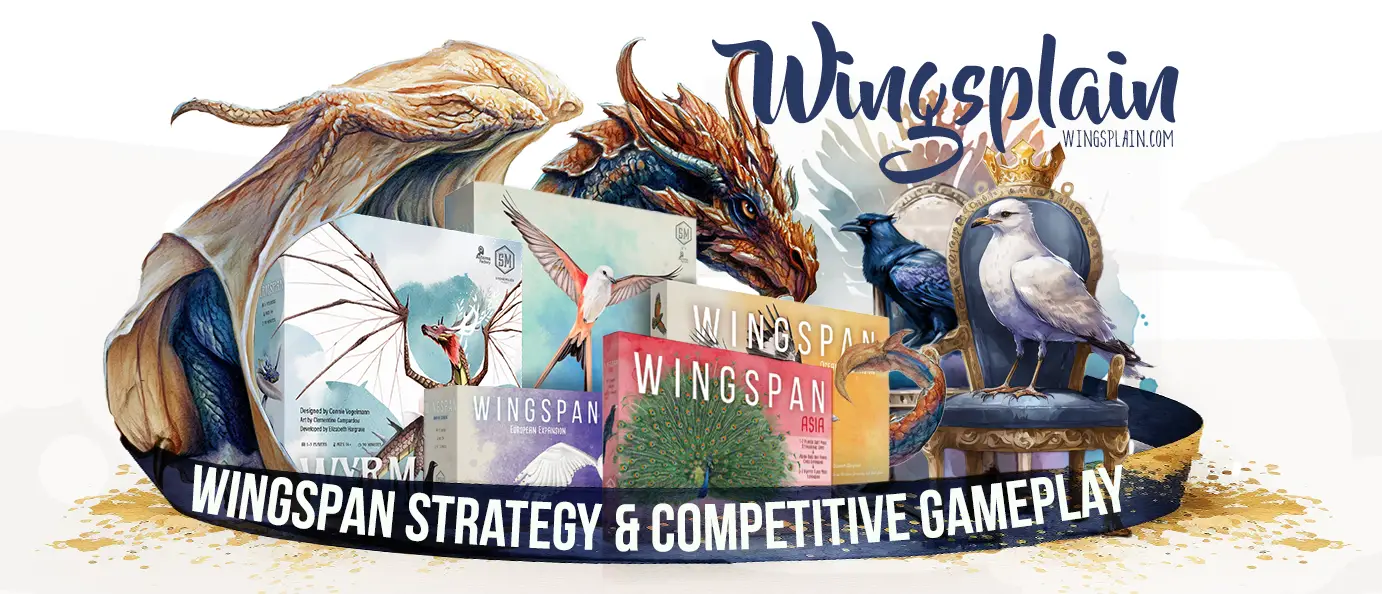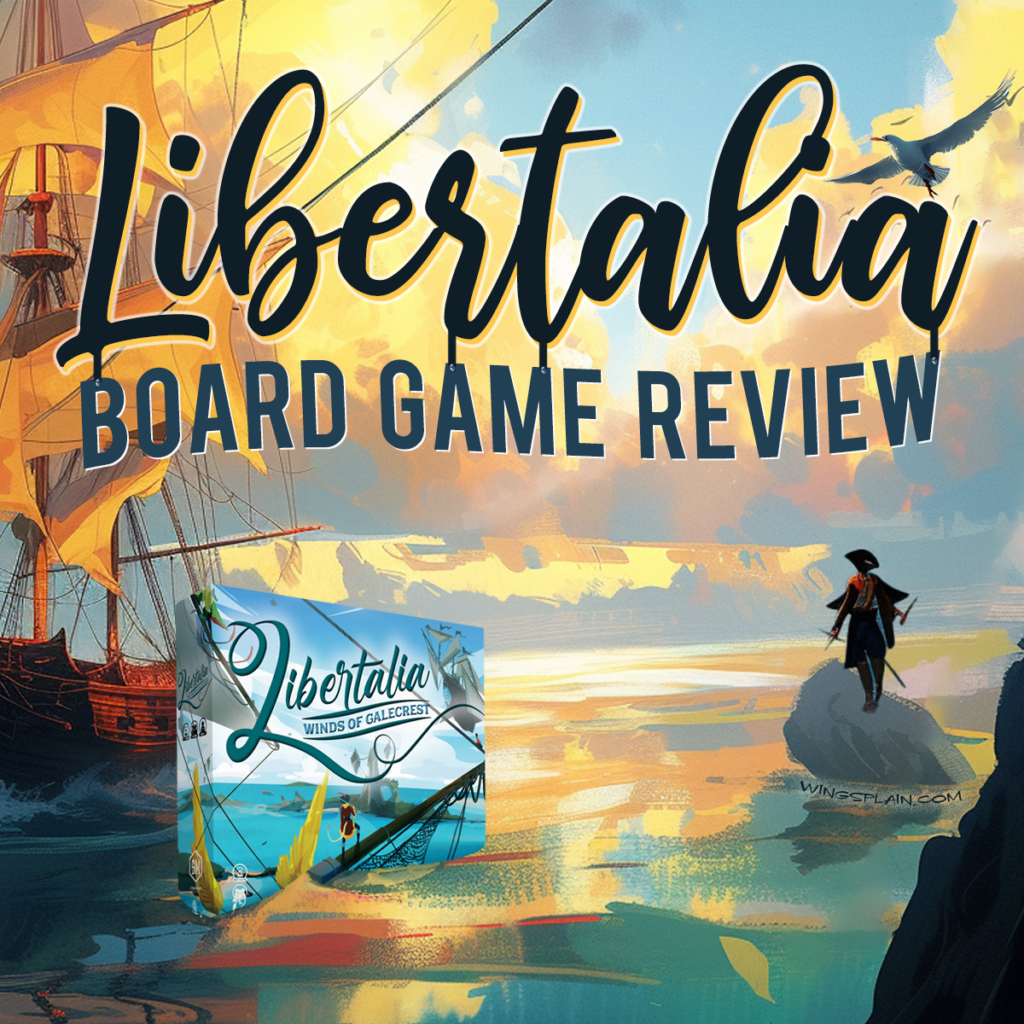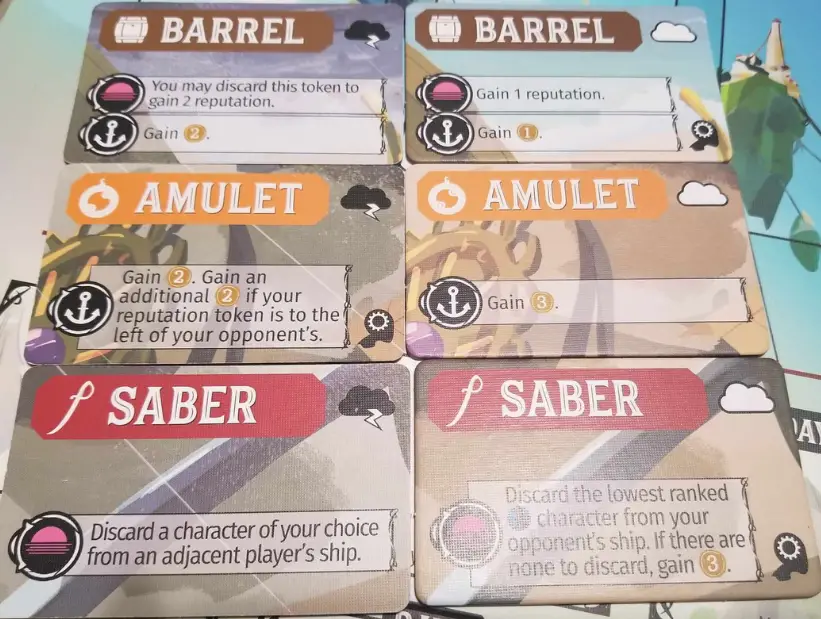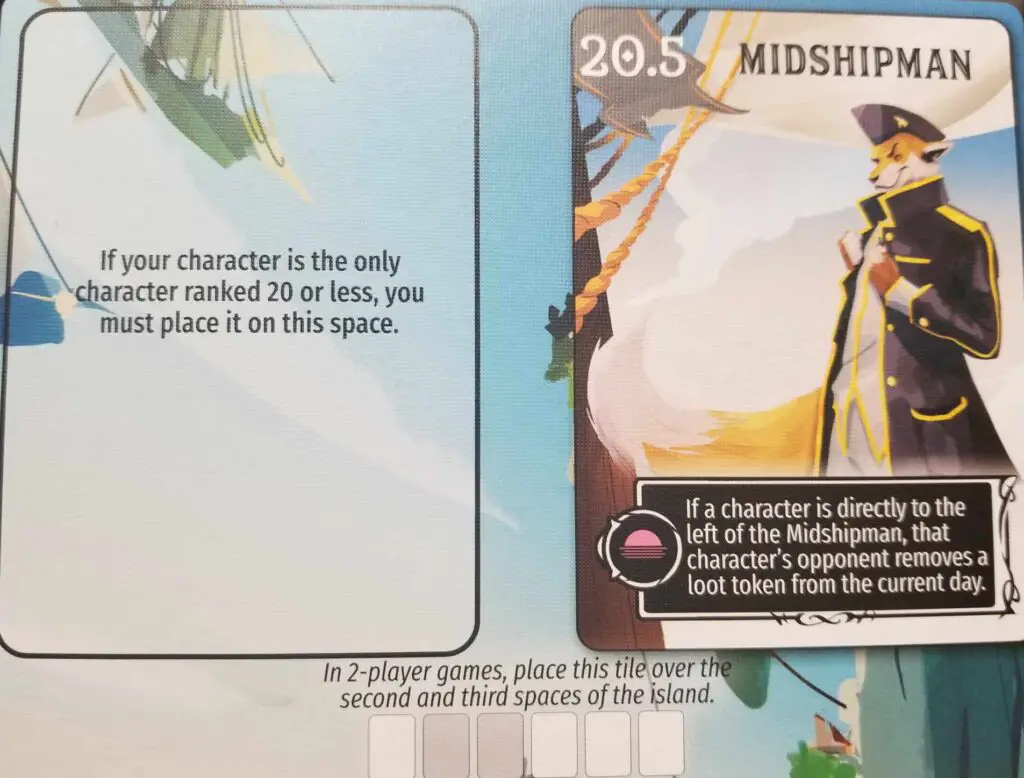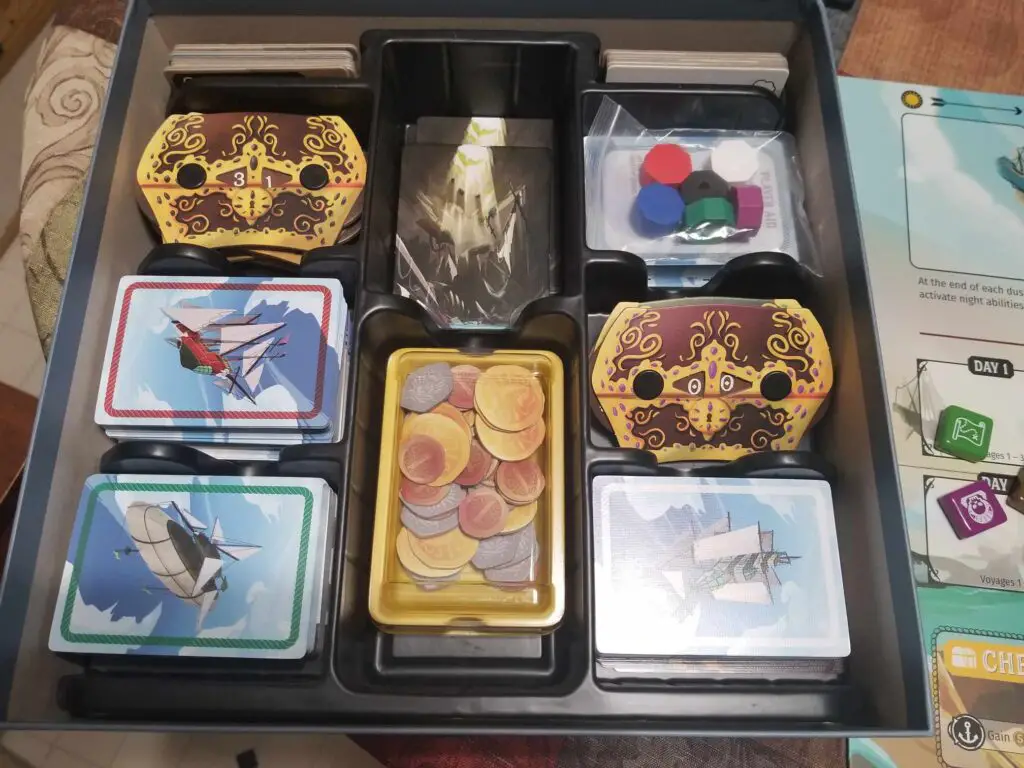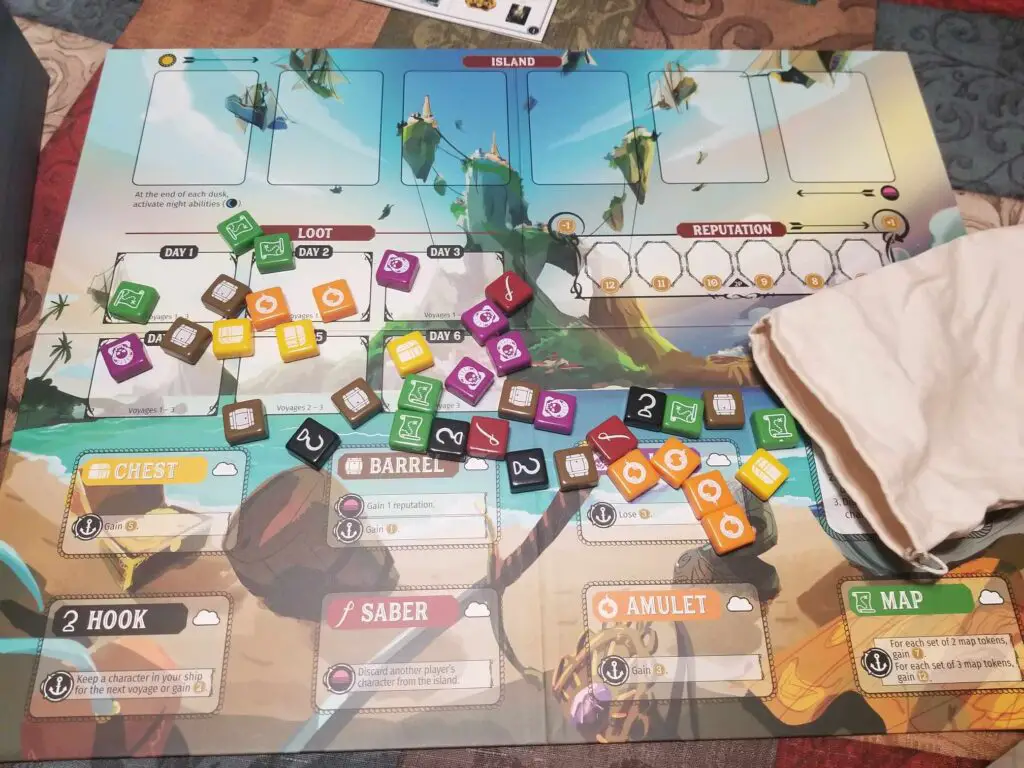Disclaimer: Wingsplain received a free review copy of Libertalia: Winds of Galecrest. We thank Stonemaier Games for this generous opportunity.
The Theme of Libertalia: Winds of Galecrest
The theme for Libertalia: Winds of Galecrest revolves around animals as pirates and their quest for loot. I think this theme is fun. The artwork is colorful and pleasing to the eye. I really enjoyed the visuals that this game presents.
There are some characters that don’t make sense on a pirate ship in retrospect, such as the Necromancer or the Preacher, but I didn’t think anything of it for a time. This might have something to do with the fact that I enjoy the fantasy genre in general, especially Dungeons & Dragons, so I’m used to seeing a wide cast of characters during my adventures.
A Libertalia Pirate’s Life May Not Be For You
Libertalia plays pretty quickly and is low complexity, although the rulebook may confuse you at first (more on that later). At times it felt like I was missing something because of how fast voyages play out once you know what you are doing. Honestly, the most complex part of the game is assembling the scoring dials and that’s not hard at all.
Something that everyone needs to be aware of before playing is that there are a lot of “take that” elements. It’s part of the core gameplay. You need to be the type of player who can accept that and understand that there will be times that you pull into the lead and the other players will be incentivized to play negative effects on you.
Other times people will be forced into playing negative effects because that’s just the remaining cards that they have in their hands. You may even hurt your own game if you don’t play your pirates in the correct order. “Take that” gameplay is felt even more profoundly in the two-player experience, where 100% of your negative effects will be focused on just one person. If one player puts together a string of these effects, the other player is going to have a poor experience.
This is where the two different sides to the player board can come into play. There is a “nicer” side (white cloud) and a “meaner” side (dark cloud) of the board. The mean side scales up the severity of the negative effects that occur as the result of loot tile effects.
One cool element of the game is that it includes tiles that are copies of all the “nice” and “mean” anchor abilities. This allows you to use either side of the board and customize your game to be as mean or nice as you want. I think this was a very good addition since it gives players a lot of control over how much pain they want to inflict on one another. There’s even a blank tile so you can come up with your own effect.
In the two-player experience, the Midshipman won’t be making any friends with his ability to “punish” a player for consistently playing the pirate with the lowest number. There will be a lot of tactical gameplay revolving around him specifically. In practice, The Midshipman’s power to remove loot tiles can feel like an extra “attack” that can be played on someone by allowing one player to remove a loot tile before the other player gets a chance to collect the one they want.
This character is a new element that they added to Libertalia to simulate the impact that a third player might have on the game. I think this speaks to the true nature of the game and its desire to be played with a larger group of people.
In general, there is a lot of tactical gameplay and psychological warfare built into Libertalia. Players are dealt the exact same pirates each day so they start on a level playing field. The less experienced players are at risk of being locked out of the game by the experienced players and this has the potential to really turn some people off. Some extra encouragement and pulling your punches a bit may be required when teaching people how to play.
When experienced players face each other, you may often find yourselves in a game of chicken, where everyone is trying to slowly maneuver the others into a bad position. You can feel a bit more depth to the game in these scenarios. Someone will eventually be forced to take a leap (due to decreasing hand sizes) which will unplug the game and create a series of bombastic effects.
There will also be times where there is an obvious play to everyone at the table and they all play the same pirate for an anticlimactic day. I have found this to be especially true with the Wind Nymph and The Brawler. Nobody wants their opponents to have these pirates hanging around, racking up doubloons (points) so everyone plays their copy at the same time and they are all removed during the nighttime phase.
Libertalia Pirates Want A Bad Reputation?
We found that the reputation track was counterintuitive. Initially, we were confused about how it worked but once we figured it out, we thought that it didn’t make sense to the point that we weren’t sure if we were playing it correctly. The number value at the bottom of each space goes down as your reputation goes up. This confused us until we realized that this number wasn’t your position on the track, but the amount of gold you gained at the start of each voyage. The higher your reputation, the less gold you get.
Having a high reputation negatively impacts the amount of gold you get each round. This makes sense as a balancing factor if having a high reputation actually rewards you with something but it doesn’t. There are times when you might have a tactical advantage if you are on the right-most reputation (the “7” space) and you can gain more. This will result in one gold for every one reputation you would gain.
This position also takes full advantage of the Bandit, which allows you to move all the way to the left side of the track (the “12” space), putting you in position to gain twelve gold at the start of the next voyage (five more than you would have gotten otherwise and one less gold for all other opponents, as they are shifted one space up the track each to accommodate your new position).
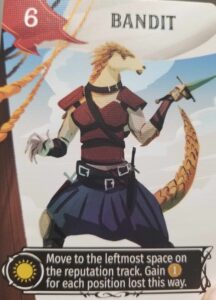
Having a high reputation is actually a detriment unless you are somehow going to continue to gain reputation consistently, accumulating extra gold with each point of reputation gained. A high reputation causes you to gain less gold (points) at the start of the next voyage. Maintaining a lower reputation voyage to voyage means you can accumulate up to five extra points per round over your opponents.
I found this baffling at first but then my wife had a good insight on this. Thematically it makes sense that pirates with bad reputations get more money. They’re pirates after all. Doing the wrong thing and lowering their reputation means they are out there doing pirate stuff.
There is a limit though. If you tank your reputation too much, you start to lose gold for each point. At the other end of the spectrum, noble pirates might have mercy on people and not take as much loot as their more notorious peers, but the more good deeds they do, the more doubloons they end up gaining for each point of positive reputation gained.
I don’t know if this is what they were actually thinking when they added the reputation track to Winds of Galecrest, but it helped us explain why the reputation track seemed to be logically backward. Let us know what your thoughts are on the reputation track in the comments below.
The Rulebook
I have never played the original Libertalia and I had not consumed any content for Winds of Galecrest before my first play-through. I wanted to go in cold and experience everything for myself as a new player for the purposes of this review.
I ended up having a bit of trouble with how the rulebook presents information. I think it is written in a way that assumes you will read it through a couple of times before you start playing. Or there is an assumption that you’ve played the original game and you mostly know how things are supposed to work.
The way I usually learn a new game is to read the rules section by section and apply them as I play. As an aside, I think this method drives my wife bonkers as she waits and listens but that’s a discussion for another time. I think some of my issues with the rules boiled down to a “me problem” but I think the game would have been well served by a short glossary on page one or a consolidated setup section containing the following information:
- Player Ships: Your ship is the space on the table in front of you where you place all your player components, such as your doubloons, loot tokens, graveyard, and cards.
- Voyages: Gameplay consists of three Voyages. Each Voyage is one round of play. See Gameplay on page four.
- Voyage one will consist of four days.
- Voyage two will consist of five days.
- Voyage three will consist of six days.
- Loot tokens are distributed to each day of the current voyage based on player count. See Setup: Before Each Voyage on page three.
If placed on page one, this short section gives you the context you need as you advance through the rule book and look at the cards and see them reference your ship or a voyage. Otherwise, I feel like the rule book requires you to have information that you may have forgotten from a previous page or information from a future page that you haven’t even read yet. When I was setting up the game for the first time and attempting to start a turn the terms “ship” and “voyage” were giving me trouble because I couldn’t find the definitions of what they were.
Again, maybe this was a me problem but I don’t consider myself someone who has problems with rule books in general. After about fifteen minutes of trying to set up the game and understand what a ship and a voyage were, my wife pulled up a “how to play” video from Rodney at Watch It Played.
I don’t usually use tutorial videos to learn how to play games but this time I decided that I had had enough of searching and decided to watch the video since my wife had it right there. As is his reputation, Rodney did a good job of explaining everything and we were on our way to our first voyage.
When we were done with our first game, I went back and read the rulebook cover to cover. Everything came together and I had a couple of facepalm moments when I realized that the definition of a Voyage was on page one (I had forgotten this information by the time I made it to Voyage Set Up) and that the day structure of Voyages was right at the top of the very next page after Voyage Set Up (this was info I was struggling to find at set up).
Then I read through Jamey Stegmaier’s design diaries to learn more about the game and its development. I found this section insightful:
“When I sat down to write the rulebook, I decided to do so without referencing the original rulebook, as I wanted it to flow naturally for this new edition. It was nice to have the original rulebook to ensure I had included everything and to compare the way we phrased the rules.”
Something that’s clear from Jamey’s writings is that he is a very experienced Libertalia player and he’s nostalgic for the original game. Understanding this, I can definitely see how the rulebook was written by a knowledgeable person who may have referenced the original rules afterward to ensure nothing was missed. In retrospect, you have to jump around a bit to find the context you need to get started with your first game.
The Components of Libertalia: Winds of Galecrest
I really like the color scheme for this game. The blues are very appealing to look at. Between the box and the board, it’s easy for me to sit and stare at it. The loot tiles are a rainbow assortment of colors and my first reaction is that the colors clash but that thought quickly fades away and it all just works.
The artwork on the cards is nice. Some of the pirates look a bit comical due to some disproportionate body parts (I’m looking at you Brawler) but I appreciate the art style and the color scheme this game brings to the table. The loot tiles give off a very appealing “clacking” sound as you dig around in the bag and their smooth polished surfaces feel nice.
The visual, audio, and tactile sensations you experience when you are playing this game is something that took me by surprise. It all comes together in an unexpected gameplay experience that targets multiple senses. I’ve never experienced that in a game before. I suppose an easy comparison to draw here would be to Azul.
I have played Azul a couple of times before but it’s been about two years. I don’t remember that game impacting my senses in the same way that Libertalia does. As I write this, I’m referencing images of the core Azul game and I can confirm that the game appears to be visually dull compared to Libertalia: Winds of Galecrest.
Final Thoughts on Libertalia: Winds of Galecrest
I would classify Libertalia: Winds of Galecrest as a “party game.” You get your friends together, you play some fast and furious games, not taking things too seriously, and then you move on to something else. This experience isn’t at its best for two players, as the “take that” nature of the game feels really bad when one person is getting “focus fired” by the other player.
I would not recommend teaching this game to someone in a two-player setting as it may turn them off to the game forever. I don’t think a three-player count is ideal either. There are few enough players that one could get “dog-piled” and that’s a frustrating experience for anyone. Libertalia: Winds of Galecrest will shine at higher player counts (four to six) because all the “take that” gameplay will be spread out over many more people and give that person who just lost something some time to breathe.
If you are a gamer who enjoys building complex webs of strategy then this game may not be for you. There is a lot of tactical gameplay and your opponents will eventually shatter your plans so it’s difficult to build anything over the long term. Winning this game will boil down to maximizing your short-term gains day after day, round after round (voyage after voyage).
If you’re a fan of fast, furious, and colorful gameplay where you fight it out with a large group of friends and don’t mind getting it as good as you give it, then Libertalia: Winds of Galecrest will be a perfect fit for your game night. If you enjoyed this Libertalia Winds of Galecrest Review, please check out our other game reviews!
